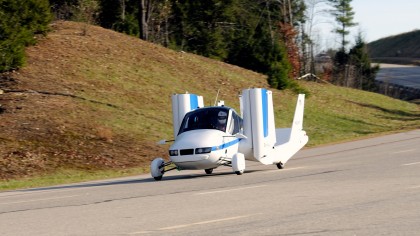Flying cars: how long until takeoff?
Sky-high ideas start to take flight

Ever since the first cars arrived on the world's roads, people have been wanting to fly them. They've become a trope of science fiction, featuring in heavyweight titles like Star Wars, Blade Runner, Back to the Future and more recently Marvel's S.H.I.E.L.D.
Flying cars are about as synonymous as jetpacks are with our concept of "the future".
But the Martin Jetpack is due to go on sale in 2014, putting us squarely within sight of that future and raising the question posed so many times over the past few decades that it's fast becoming a trope of its own. "Where's my flying car?"
Right here, says an American company called Terrafugia, which was founded in 2006 by a team of graduates from MIT led by CEO Carl Dietrich.
Terrafugia is developing a pair of flying cars - the Transition is a light aircraft whose wings fold down so that it can be driven on a road - it's been tested in flight a number of times, and isn't a huge departure from a traditional light aircraft. The more conceptual TF-X was revealed earlier in 2013 and has a fixed-wing design that can takeoff and land vertically.

"The potential benefit to humanity of a practical flying car is tremendous," says Dietrich. "The global impact of widely distributed, practical, personal airborne transportation has been estimated by the non-profit CAFE Foundation at approximately $800 billion/year. NASA has estimated it at $1 trillion/year. I believe it is impossible to quantify the benefit to humanity."
But to know whether Terrafugia is likely to succeed with its plans, it's worth looking back in history at how even the biggest automobile and aeronautics companies have crashlanded in the past when trying to launch flying cars.
Sign up for breaking news, reviews, opinion, top tech deals, and more.
A flying lesson
The story begins in 1917 with the Curtiss Autoplane. It resembled a Ford Model T with triplane wings on top, and was armed with a four-blade propeller. It never achieved full flight, however, only making a series of hops before the United States entered the first World War and Curtiss's skills were needed elsewhere.
In 1921, a Frenchman named René Tampier built a four-wheeled biplane and drove it two hours across Paris to the Air Salon, and five years later in 1926, Henry Ford himself showed off a mass-market single-seat aeroplane called the Flivver. The tiny plane was designed specifically to be small enough to fit into his office, and caused an immediate stir in the media.
It even inspired one columnist from the New York Evening Sun to write a poem: "I dreamed I was an angel / And with the angels soared / But I was simply touring / The heavens in a Ford." Sadly, however, the project was abandoned a couple of years later after an attempt at a distance record ended with the death of the test pilot.

A similar fate befell the Convair Models 116 and 118, which both resembled a car with a plane glued to the top. The 116 flew 66 successful test flights in 1946 and 1947, spurring the development of the 118, which Convair hoped would be rented from airports in large numbers.
Sadly, however, the second test flight of the Model 118 ended in disaster after the pilot took off with little to no fuel aboard. Although he checked the fuel gauge before takeoff, it turned out that he had checked the car's fuel gauge, not the aircraft's, and was forced into a crash landing shortly thereafter. Happily, the pilot walked away with only minor injuries, but the 118 wasn't so lucky, and Convair swiftly lost its appetite for flying cars.
Ford returned in 1956 with the Volante Tre-Athodyne, a sleek-looking 3/8-scale concept that used ducted fans to lift it off the ground. The company happily admitted in a press release that "the day where there will be an aero-car in every garage is still some time off". They weren't wrong.
